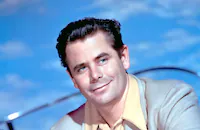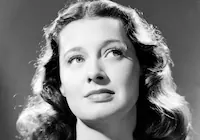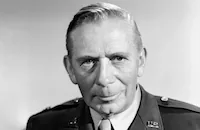The Man from Colorado

Brief Synopsis
Cast & Crew
Henry Levin
Glenn Ford
William Holden
Ellen Drew
Ray Collins
Edgar Buchanan
Film Details
Technical Specs

Synopsis
In Colorado, during the waning days of the American Civil War, a trigger-happy Union colonel, Owen Devereaux, orders his troops to attack a surrendering Confederate force at Jacob's Gorge. The unprecipitated attack is brutal and continues until Devereaux's unit decimates the Confederates, killing more than one hundered soldiers. Following the battle, Devereaux's second in command, Captain Del Stewart, discovers that the Confederates had signalled their surrender before the battle commenced. Later, following an announcement that the war has ended, Devereaux writes in his diary that the war made him "crazy" and that he could not stop himself from ordering the attack. The colonel's erratic behavior continues when he orders the arrest of one of his soldiers, Sgt. Jericho Howard, who was merely caught celebrating the end of the war. In his hometown, Devereaux is greeted with a hero's welcome and a parade proclaiming him "The Man from Colorado." Things appear to look up for Devereaux as he is reunited with his sweetheart, Caroline Emmett, and appointed to serve as a Federal judge. However, the colonel's troubled thoughts begin to consume him once again as he becomes jealous of Caroline's affections for Del. During a celebration for Devereaux, a Confederate soldier who survived the battle against Devereaux's regiment confronts the colonel at gunpoint and demands an explanation for his order to fire upon the surrendering army unit. Del and Doc, the town doctor, both witness Devereaux's angry reaction, in which the colonel beats the soldier and then shoots him dead. After Devereaux is sworn in as judge, he appoints Del as his Federal Marshal and assigns him to tend to Corporal Dixon, who, it has just been learned, has been pistol-whipped by a gang working for Big Ed Carter. During the war, Carter, the owner of the Great Star Mining Company, laid claim to land belonging to many of the absent soldiers, and is now using strong-arm tactics to keep the land. When Devereaux tells Del that he intends to marry Caroline, Del expresses his concern that he is mentally too "sick" to marry her, and Devereaux responds by striking Del. Jericho, meanwhile, has escaped from his detention and has formed a gang to rob the Great Star's safe. During the robbery, Jericho is shot in the hand, and his gun, bearing the inscription "J. Howard," is left behind. Jericho's brother Johnny is arrested for the theft, and although Del convinces Jericho to confess his guilt to save his brother, Jericho arrives too late to prevent Devereaux's execution of Johnny. The execution infuriates Del, who vows to "finish" the colonel. After escaping from a trap set by Devereaux, Del goes into hiding with Caroline, who married Devereaux, but has the diary and now fears him. Determined to find Del, Devereaux sets fire to the entire town to drive him out of hiding. Del finally emerges from a burning building, and Devereaux is about to shoot him when a building facade collapses on the colonel and kills him. Del and Caroline survive the fire, and Del leaves for Washington to take a new job.

Cast

Glenn Ford

William Holden

Ellen Drew

Ray Collins

Edgar Buchanan

Jerome Courtland

James Millican
Jim Bannon
Wm. "bill" Phillips
Denver Pyle
James Bush
Mikel Conrad
David Clarke
Ian Macdonald
Clarence Chase
Stanley Andrews
Myron Healey

Craig Reynolds
David York
Helen M. Gereghty
Crew
Robert D. Andrews
Fayte Browne
Borden Chase
Sidney Clifford
George Cooper
Francis Cugat
George Duning
Stephen Goossón
Natalie Kalmus
Jean Louis
Ben Maddow
Frances Mcdowell
Wilbur Mcgaugh
Walter Meins
Wilbur Menefee
Charles Nelson
Arthur Rosson
Jules Schermer
William Snyder
M. W. Stoloff
A. Leslie Thomas
Homer Van Pelt

Videos
Movie Clip



Film Details
Technical Specs

Articles
The Man from Colorado
Columbia Pictures spent quite a bit on this film. At one point the crew dynamited the side of a 1500-foot mountain in California's San Fernando Valley in order to create a deep gorge as called for by the script. And the western town they constructed was one of the largest location sets ever built by Columbia up to that time. During filming of a massive fire scene at the end, however, the set caught fire uncontrollably, and Holden and Ford tried to actually fight the fire until firemen could arrive. "Dad came away coated in black soot, with burns to his arms and hands," Ford's son Peter later wrote.
Columbia had borrowed Holden from Paramount for this picture, and he and Ford greatly enjoyed working together for the second and last time in their careers, following Texas (1941). The two had started working in Hollywood at the same time and followed very similar career trajectories, maintaining a playful competitiveness and a deep friendship over their whole lives.
The Man from Colorado opened in late 1948 as the lead film of a double bill with Manhattan Angel (1949), a B film starring Gloria Jean. It received uniformly excellent reviews, with Variety calling it "a fine, tense western melodrama" and The Hollywood Reporter declaring it to be "a good story, a thrilling production, [with] fine performances and dynamic direction... Glenn Ford's performance of the sadistic judge is one of his best."
The film's satisfying story and good notices belied some tense drama going on behind the scenes. Originally, the movie was to have been directed by Edmund Goulding, but he was replaced in preproduction by Charles Vidor. Vidor had previously directed Glenn Ford in Gilda (1946) and three other pictures, but at the moment, the two men did not get along.
A few months earlier, Ford had testified against Vidor in court. Vidor, who had just married Harry Warner's daughter Doris, wanted to get out of his Columbia contract so he could work at the more prestigious Warner Brothers. To that end, he sued Columbia and its chief Harry Cohn, claiming that Cohn's verbal abuse over the years was grounds for termination of contract and other damages. Glenn Ford was among those who testified that Cohn's rants were generally not to be taken seriously, that it was just the way Cohn operated. Ironically, Vidor's case was punctured even more when other witnesses testified as to Vidor's own temper tantrums on his film sets.
In any event, Vidor now hated Glenn Ford so much that he refused to speak to him even on the set, relaying direction instead through an assistant. Eventually, Ford complained to Cohn, who at first didn't care, but ultimately fired Vidor off the picture and placed him on suspension because he was moving too slowly and causing the film to go over budget. Some historians have written that Vidor dragged out the shooting purposefully, as a way of retaliating against Cohn. Cohn replaced Vidor with director Henry Levin (who received sole screen credit), but the shoot still wound up almost doubling in length.
According to a 1948 news clipping, a brooch that Ellen Drew wears in a ballroom scene is the actual brooch worn by the wife of Colorado's first governor, William Gilpin, at a June 1861 inaugural ball. Gilpin's great-great-granddaughter, identified as "an ardent fan of Drew's," lent her the heirloom for the film. "Miss Drew gladly accepted," said the article, "but she was on pins and needles during filming of the scenes for fear something might happen to the valuable brooch."
by Jeremy Arnold
Sources:
Michelangelo Capua, William Holden: A Biography
Peter Ford, Glenn Ford: A Life

The Man from Colorado
Ellen Drew, 1914-2003
She was born Esther Loretta "Terry" Ray on November 23, 1914, in Kansas City, Missouri. The daughter of a barber, her family moved to Chicago when she was still an infant and she lived a very quiet childhood far removed from the glamour of Hollywood. She was encouraged by some friends to enter a beauty contest when she was just 17. After winning, she tried her luck in Hollywood, but found that they were no immediate offers for her particular talents.
She eventually took a waitressing job at C.C. Brown's, a famed Hollywood Boulevard soda fountain, and had virtually abandoned her dreams as a starlet when William Demarest, a popular actor's agent and well-known character actor, spotted her. Demarest arranged a screen test for her at Paramount, and she was promptly placed under contract for $50 a week.
For the first few years, (1936-38), Drew got only bit parts, and was often uncredited. When she finally got prominent billing in the Bing Crosby musical Sing You Sinners (1938), she decided to change her name, from Terry Ray to Ellen Drew. She earned her first major role in Frank Lloyd's If I Were King (1938) opposite Ronald Colman, yet for the most part of her career, rarely rose above "B" material and second leads. Still, she had some fine exceptions: Preston Sturges' enchanting comedy Christmas in July (1940), with Dick Powell; Tay Garnett's lighthearted war romp My Favorite Spy (1942) co-starring Kay Kyser; Julien Duvivier's taut The Imposter (1944), holding her own with a brooding Jean Gabin; and Mark Robson's chilling low-budget chiller Isle of the Dead (1945) opposite Boris Karloff. Drew made some notable television appearances in the late '50s including Perry Mason and The Barbara Stanwyck Show, before retiring from the entertainment industry. She is survived by her son David; five grandchildren; and five great-grandchildren.
by Michael T. Toole
Ellen Drew, 1914-2003
Quotes
Trivia
Notes
A January 1947 Hollywood Reporter news item indicates that Edmund Goulding worked on this film's screenplay for two weeks but left the picture due to a "difference of opinion" with producer Jules Schermer. The extent of Goulding's contribution to the final film has not been determined. Charles Vidor directed the first three weeks of filming, but was replaced by Harry Levin following a dispute with Columbia production executive Harry Cohn. The feud was viewed by many as an extension of a dispute that began in 1946, when Vidor sued Columbia for termination of his contract, and when Columbia responded with a countersuit. In a public statement issued by Columbia and printed in Hollywood Reporter in March 1947, the studio said that it was "dissatisfied with the progress being made with Mr. Vidor in the shooting of the picture." Vidor responded to the studio's charges by stating that he had been given a mere 48-day shooting schedule, and that "such a picture could not be made in under 75 days." Vidor also stated that Columbia deliberately cast Glenn Ford in the picture knowing that animosity existed betweeen the two men since Ford testified as a character witness against Vidor in Columbia's 1946 countersuit. The legal matter remained unresolved for over three years. During that period, Vidor formed an independent production unit, The Beckworth Corp., but made only one film, The Loves of Carmen. In 1949, when Vidor refused to direct The Petty Girl, Columbia suspended him and sued him for breach of contract. On October 17, 1949, the day that Columbia's suit against Vidor was to go to trial, Daily Variety reported that a settlement had been brokered by M-G-M production chief Louis B. Mayer. Mayer reportedly intervened in the dispute in order to "avert a repetition of the name-calling and black headlines that marked the last Columbia-Vidor court fight." In exchange for the abrogation of his contract with Columbia, Vidor agreed to pay the studio $15,000 a year for five years.
A February 1947 news item in Los Angeles Examiner noted that Melvyn Douglas was set as Ford's co-star. According to a May 1947 Hollywood Reporter news item, an explosion and fire destroyed part of the film's Jay Corrigan Ranch location set in Simi Valley, CA, and resulted in the hospitalization of bit actress Helen M. Gereghty. Gereghty's participation in the final film has not been confirmed. Columbia borrowed William Holden from Paramount for the production.
















